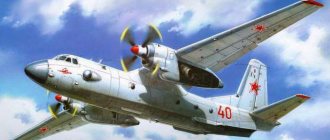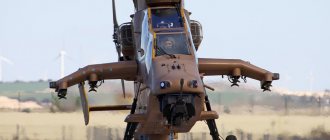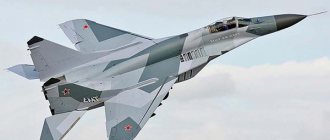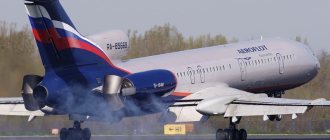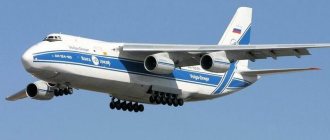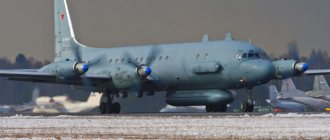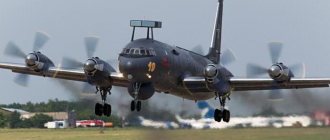Exactly one year after the end of World War II, OKB-13 (an experimental design bureau) was created in Novosibirsk, headed by a young (he was not yet forty years old) aircraft designer Oleg Antonov. Six years later, the OKB moved to Kyiv, which determined its fate in the 21st century. For the high-wing An-12, Antonov was awarded the Lenin Prize and became the general designer. Despite the supposedly unlucky design bureau number, Antonov “raised” the An-72 (1977), An-124 “Ruslan” (1982) and An-74 (1983) into the sky. After the death of Oleg Konstantinovich Antonov, in 1984 g., OKB was named after him.
After the collapse of the USSR, Antonov became a state enterprise. The regional aircraft An-140 (1997) and An-148 (2004) were created using old developments and personnel. The degradation of the OKB after the death of successor O.K. Antonov in 2006 is obvious. Problems started with the An-158 model (2011). The world's only commercial user of this aircraft, Cuba, which has only six copies, suspended their operation in 2015. Over the past two years, the Antonov State Enterprise has done nothing and was liquidated in July last year.
Coanda effect
The leading designer chose the implementation of the Coanda effect as the main “highlight” of the project. Without delving into the theory of aerodynamics and technical details, it is enough to say that the engines located in a special way above the wings created an additional (up to 20%) impulse and thrust from the meeting of the gas jet with the surface of the wing. In an effort to reduce the landing distance as much as possible, a parachute was introduced into the braking system, and to reduce instability, the shape of the tail unit and fin were changed. The cargo hatch was also moved to the tail.
The testers had only positive things to say about the prototype; all the characteristics were excellent:
- Cabin ergonomics, reliability and up-to-date equipment.
- Reduced noise level.
- Easy to control and good maneuverability.
- Used composite materials: glass and carbon fiber.
Everyone was so amazed by the results of the unfinished tests of the An-72 that they launched it into serial production in 1977, without even waiting for them to be completed (the foreign analogue - the Boeing YC-14 - never went into production). Civil aviation was also interested in such an aircraft, but it needed something different both in terms of payload capacity and range. As a result, both were increased.
It took time to produce an almost new aircraft, and its first prototype was released in 1985. Finally, in 1989, the An-72 finally took off. The first copies were “saddled” by the staff officers (in the army this aircraft was called the general’s plane), but it did not take root with the paratroopers (the command vehicle fit inside the An-72, but the landing vehicle did not). In rough work, both military and civilian, this machine proved to be a hard worker, for which it received an additional nickname - Camel.
Development[ | ]
At the initial stage of development of the new aircraft, the initiative came from the Design Bureau itself due to the need to spend the allocated budget money, since otherwise the remaining unrealized funds were withdrawn, and the next year the bureau’s funding was cut. The proposal met with the support of the Air Force General Staff, which was interested in creating a light transport aircraft for transporting troops and equipment in the front line and supplying airfields. The requirements for the aircraft were approved jointly by representatives of the Design Bureau, the Air Force Order Directorate and the Ministry of Aviation Industry. The OKB's technical proposal included the design of a front-line transport aircraft with a payload capacity of up to 5 tons and the ability to airdrop. The aircraft had to have relatively small dimensions for basing and camouflage, high rate of climb and strength to ensure takeoff and landing on poorly prepared sites.
After agreement and approval, the topic of a light front-line transport aircraft was included in the OKB work plan. Ya. G. Orlov was appointed lead designer of the aircraft. The main emphasis in achieving KVP was on the use of the Coanda effect: O.K. Antonov figuratively described to employees how “a powerful flow of gases flowing at high speed from the nozzle of a jet engine will pass over the wing, creating additional lift.”
Theoretical calculations were confirmed by experimental blowing of aircraft models in wind tunnels: the increase in lift was quite significant and reached 20% in some modes. The wing blowing became especially effective when the mechanization was released: the “sticking” of the jet ensured continuous flow and a significant increase in quality during takeoff and landing. At the same time, the wing, flap and engine simultaneously took part in creating the lifting force, and to study their interaction it was necessary to conduct research on special full-scale stands simulating the airflow of the wing and mechanization.
Description of the An-72 aircraft and its features
Where was this plane produced? . “Cheburashka,” as it is popularly called for its two engines rising above the wings, is a high-wing aircraft with swept wings. He is a unique transport worker who still serves in the armed forces of the Russian Federation.
The An-72 fully complied with the requirements for short take-off and landing vehicles (hereinafter referred to as STOL):
- Light weight and decent speed.
- The acceleration track is not long - the quality is average or lower.
- Stable, subject to the prescribed landing speed, and its extraordinary trajectory.
- He literally, and not figuratively, “jumps” up.
When landing, it was necessary to observe the rule of reduced speed (up to 165 km/h) and then Cheburashka, or, as it was called in Europe, the Coal Miner, could land on a field with hummocks with an area equal to a square kilometer (17 standard garden plots with an area of six acres), and its mileage on the ground was less than four hundred meters. Half a kilometer was enough for him to take off.
Operators[edit]
An-72 of the Russian Navy. The front view is reminiscent of Cheburashka.
An-72 of the National Guard of Ukraine at Zhulyany airport
Kazakhstan Border Service Antonov An-72-100
Civilian operators[edit]
In August 2006, a total of 51 An-72 and An-74 aircraft were in airline service. Major operators include Badr Airlines (three) and Shar Ink (eight). About 17 other airlines have smaller numbers of this type of aircraft. [9]
Sudan
- Badr Airlines
- Green Flag Airlines
Ukraine
- Motor Sich airlines
- Antonov Airlines
Military operators[edit]
As of December 2022, 42 aircraft are in service: [10]
Angola
- Angolan Air Force: 6
Equatorial Guinea
- Equatorial Guinea Air Force: 1
Kazakhstan
- Kazakhstan Air Force: 1
Libya
- Libyan Air Force: 1
Russia
- Russian Air Force: 28
- Russian Navy: 5
Former military operators[edit]
Armenia
- Armenian Air Force
Georgia
- Georgian Air Force
Libya
- Libyan Air Force
Moldova
- Moldovan Air Force: two
Peru
- Peruvian Air Force - two (operated until the end of the 1990s and sold to the civilian market)
Soviet Union
- Soviet Air Force
Interesting Facts
Even during test flights, as well as at the very beginning of operation, three world records for altitude and flight speed were set.
In 1986, an expedition to the planet's Polar Pole was saved. Thanks to a short runway of snow and ice (300 m), the AN-72 took off with 27 passengers - members of the expedition.
In 1987, in polar night conditions, the plane flew more than twenty thousand kilometers from Chukotka to Antarctica, landing on a site ineptly prepared by scientists.
Modifications
Coal Miner modifications:
- The An-72 is a basic aircraft mainly for military purposes.
- 72AT. The vehicle is used to deliver the same type of cargo, mainly military.
- 72A is an Arctic version of the aircraft. It is used for both civilian and military purposes.
- 72R is a military reconnaissance aircraft using modern means.
- 72C – “general” aircraft with an improved interior.
- 72B – export military version.
- 72P. it is used by border troops to monitor the coastal area.
Modifications[ | ]
| Modifications of the An-72 aircraft family[6] | ||
| Type | Description | Units built |
| An-71 | Airborne early warning aircraft (AWACS). | 3 |
| An-72 (according to factory documents - 72.04) | Transport plane. | ~ 35 |
| An-72 (according to factory documents - 72.10) | Passenger aircraft in the “lounge” version. | ~ 60 |
| An-72-100 | Transport aircraft certified according to international standards. | |
| An-72-100D | Passenger aircraft in the “lounge” version, certified according to international standards. Production vehicles were re-equipped. | 3 |
| An-72A "Arctic" | A converted experimental An-72, later developed as the An-74 [7]. | 1 |
| An-72AT | Modification for transportation of standard aviation containers. | |
| An-72V | Transport plane. Export modification, developed for the Peruvian Air Force. | 1 |
| An-72P | The first flight was carried out on November 29, 1984.[8] An aircraft for patrol duty in a 200-mile sea zone adjacent to the coast. Sighting, navigation and flight equipment provides automatic aircraft navigation at all stages of flight, bringing the aircraft to a given point, instrumental search, determining the coordinates of surface vessels, their speeds and courses of movement. To suppress the actions of infringing vessels, the An-72P is armed with a GSh-23L cannon with 250 shells, two units of unguided missiles and four 100 kg caliber bombs. Photographic equipment installed on the aircraft provides aerial photography of targets in the daytime and, using SFP-2A lighting cartridges, at night. Also called An-76 [9]. | 18 |
| An-72PS | Search and rescue aircraft. | 1 |
| An-72R (“product 88”) | Electronic reconnaissance aircraft. Developed as an analogue of the Boeing E-8A J-Stars. Intended for radar reconnaissance and detection of ground targets at long distances and targeting of ground and air weapons at them. (AiV No. 3/2008). Production vehicles were re-equipped. | 4 |
| An-72S | Administrative aircraft. | |
| An-74 | Multi-role aircraft. Created for use in the Far North, there are both civilian and military modifications (patrol and military transport). | 81 |
| Deck version of An-72 | Design work was carried out in 1982-83. For deployment on an aircraft-carrying ship, the vehicle had a folding wing. The takeoff was to be carried out using a springboard, and the landing was to be carried out using an arresting aid. For takeoff, it was planned to equip the aircraft with 1-2 booster engines in the tail section and two powder accelerators. The project was not implemented.[10] | |
An-72 - technical characteristics
What characteristics does the aircraft have?
- Crew – from 3 to 5 people.
- Length – 28.1 m.
- Height – 8.65 m.
- Wing span – 31.9 m.
- Minimum weight – 19.5 thousand kg.
- Maximum take-off weight – 34.5 thousand kg.
- Maximum fuel weight is 13 thousand kg.
- Cargo capacity - 10,000 kg of anything, including 70 military personnel or 25 seats for “cargo 300” and those accompanying it.
- The power plant is two Progress turbojet engines.
- Maximum speed – 720 km/h.
- Normal speed is 575 km/h.
- The maximum flight distance (without cargo) is up to 5.0 thousand km.
- Flight distance with maximum load is up to 1.2 thousand km.
- The altitude limit is 10.1 km.
- Take-off run – up to 0.8 km.
- Landing mileage – up to 0.45 km.
Weapons:
- small arms and cannon – 23-mm GSh-23L cannon in a universal cannon container on a suspension;
- 2 unguided missiles S-5 (57 mm, range 1.8 km) on a suspension;
- 4 FAB-100 bombs on suspensions.
Inside
The An-72 cabin (interior) resembles a transforming toy. You can perform various manipulations with it, changing the internal space in any way.
And four windows, distributed equally across two compartments of different classes (for the passenger version), may end up in one compartment (for the cargo version) of the cabin with a total volume of more than 40 m3 (9.0 * 2.2 * 2.15 meters).
The model of the An-72 military transport aircraft can also be called innovative because for the first time in Soviet transport aviation, navigation systems replaced the navigator.
Also for the first time, a new design and location of the cargo hatch and ramp was used. When carrying out loading and unloading operations, the ramp rolled out from the tail of the aircraft, lowering for ease of loading, and during flight it went under the belly of the aircraft. The cabin has a special mooring device, a beam crane and folding seats. Loading and unloading takes 15 minutes, refueling takes another ten. The crew fits into one passenger car.
History of appearance
The development of the military transport An-72 began with the goal of replacing the turboprop An-26 in 1972 on an initiative basis at the Antonov Design Bureau. Ya.G. Orlov was appointed as the lead designer. As a power plant, it was decided to use the D-36 DTRD of the Zaporozhye MKB "Progress", the dimensions of which were the only ones suitable in size. The official basis for the start of construction was the joint decision of the Air Force, MGA and MAP dated May 27, 1974. Already in May 1975, a model of the future An-72 aircraft was demonstrated to the commission headed by P.V. Bazanov.
In June 1976, Resolution of the Council of Ministers of the USSR, as well as the Central Committee of the CPSU No. 558-186 on the creation of the An-72, was issued. The new product was required to provide short takeoff and landing. For this purpose, the wing was equipped with advanced mechanization. To increase the lift of the wing during takeoff, the designers decided to blow the exhaust jets of the engines onto the flaps, using the Coanda effect
In addition, the high location of the engines protected them from the ingress of various foreign objects, which was important when based at unpaved airfields. The use of an automated navigation system, which is interfaced with a radar, made it possible for the crew to abandon the need for a navigator, which was the first time on a Soviet military transport aircraft
In 1977, the first cargo prototype was built at the Kiev Aviation Plant. Its first flight was carried out under the piloting of test pilot V.I. Tersky on August 31, 1977. In the same year, flight tests of the second prototype began. At the Kiev Aviation Plant in 1978, preparations for serial production began. 5 An-72s were produced, but due to the plant’s workload, production of the An-72s was transferred to the Kharkov aircraft plant. During the development of production, technical changes were made to the design to increase the flight range. As a result, the wingspan was increased by 5.4 m, the fuselage was lengthened by 1.4 m. At the same time, the takeoff weight increased by 10 tons, the speed decreased, and the takeoff and landing characteristics deteriorated slightly. In 1979, at the aerospace show in Le Bourget, the An-72 was first demonstrated to the general public. The first production An-72 took off in 1985, in December.
Chassis
Consider the An-72 chassis. During the design process, more than three dozen schemes were studied, including “exotic” ones. The chassis ensures that the “coal miner” fulfills its main feature - landing almost anywhere (a field with hummocks, a dirt country road, snow cover and even ice floes in Antarctica) with a range of up to half a kilometer. If the hydraulics failed, the five-support retractable landing gear was released mechanically (there are no corresponding locks). The An-72 can land without much inconvenience on its three main struts and its nose strut if one breaks. In terms of load on one wheel, the “binoculars” were inferior to even the more advanced and modern Il-76.
The Arctic version of the An-72 or, as it was later called, so as not to be confused, the An-74 (namely, since there were practically no differences from the 72A model) became indispensable for use in all spheres of life in the Siberian expanses and in the harsh climate of the Extreme North of Russia and Antarctica. It was additionally equipped with seats for a navigator and a hydrologist.
Red stripes have been added to the tips of the tail and wings for greater visibility, plus special paint for icing control. Equipped with a convex, streamlined porthole (the visibility has become better) and a corresponding tipper for cargo if landing is not provided.
Construction[ | ]
Workplace of the assistant commander of the An-72.
Cut-up D-36 engine, Samara University. High wing with swept wing (11°). The unusual arrangement of the engines on top of the wing in a forward engine nacelle increases lift due to the Coanda effect. When the slats and flaps are deflected, the jet stream escaping from the engine nozzles “sticks” to the wing, flowing without separation around the upper surface of the wing and flap, accelerating the air flow above it. According to the laws of aerodynamics, an increase in flow speed leads to a decrease in air pressure. And the greater the pressure difference under and above the wing, the greater the lifting force, and therefore the takeoff and landing characteristics of the aircraft improve.[4]
The aircraft's wing, with an area of 89.6 m2, has powerful mechanization: almost its entire trailing edge was occupied by retractable flaps (double-slotted on the center section and three-slotted on the consoles), and slats were installed along the leading edge of the consoles. On the upper part of the center section and consoles there are four sections of interceptors. External spoilers are designed to work in conjunction with ailerons and dampen lift when descending with a steep glide path onto areas of limited size. Internal ones are used during a run or in the event of an aborted takeoff to increase the aircraft's drag and the load on the landing gear. The use of spoilers can increase braking efficiency by 20%. In addition, to reduce the mileage, the engines are equipped with a thrust reverser, and a braking parachute is installed in the tail section of the aircraft.
The fateful moment of the entire project was, first of all, the availability of a suitable engine - the D-36 turbofan with a take-off thrust of 6500 kg. Although O.K. Antonov was a staunch supporter of economical turboprop engines, it was turbofan engines with a high bypass ratio that made it possible to implement the Coanda effect in practice. The D-36, created at the Progress Design Bureau by V. A. Lotarev, provided sufficient air flow and, what is especially valuable, a relatively “cold” exhaust stream of gases directed to blow the wing.
To ensure directional stability, the aircraft has a powerful keel. The rudder has an original double-joint design, which increases its efficiency at low speeds, and is divided into two sections in height. The lower rear part of the steering wheel is controlled directly by the pilot's pedals, and the rest by the boosters of the control system. To reduce efforts in the control system in a wide range of flight modes and aircraft alignments, the rudders have weight and aerodynamic balancing, the lower section of the second link of the rudder is equipped with a trimmer, and the elevator is equipped with trimmers and servo compensators. This solution allows pilots to counter the imbalance of the aircraft when releasing the wing mechanization (in this case, the flow pattern around the aircraft changes dramatically and at low speeds it literally “hangs” on the engines) and pilot the aircraft manually even if the boosters fail.
Gondola of the main supports - there are no locks for the retracted position of the supports, wear from the wheel is visible on the sash
The aircraft's cargo cabin, measuring 9000x2200x2100 mm, provides accommodation for a typical range of transported cargo, including up to 32 soldiers with weapons, GAZ-66 and UAZ-469 vehicles, aircraft engines, standard containers and cargo pallets. The ramp device had a patented Antonov design: when loading and unloading, it lowers to the ground, and to dump cargo in flight, it rolls back along a guide under the fuselage. When designing the “aircraft 200,” special attention was paid to the design of the landing gear: the company already had solid experience in this area—all of its machines could be operated from unpaved airfields. In terms of indicators such as equivalent single-wheel load (the proportion of the aircraft's mass attributable to each of the landing gear wheels) and ground maneuverability, the An-72 was superior to even the more modern Il-76. However, now the task was posed somewhat differently - the plane had to be able to take off and land on areas with wet and uneven surfaces.
Ultimately, the choice was made in favor of a conventional retractable landing gear with a steerable front strut and four powerful main struts with independent wheel suspension. The strength and energy absorption of the shock absorbers were calculated to overcome a “standard bump” up to 35 cm high. To increase safety, the main struts do not have locks in the retracted position, which could become clogged with dirt on takeoff and not open. The retracted struts lie on the landing gear niche doors and are released freely when they are opened. If the hydraulic system fails, the chassis is released under its own weight - the door locks are manually opened through cable wiring, the supports are released, then the doors are closed with a special winch. If one of the main struts fails, the plane can land on the remaining three[5].
Flight accidents and disasters
This is a fairly reliable aircraft and has been in operation for more than 30 years in both military and civil aviation. But there were also An-72 disasters, including the death of the crew and passengers:
- Autumn 1971. Near the city of Lensk, due to overload and destruction of mechanization, I collided with a hill. All 13 people on board were killed.
- Summer 1994. Emergency landing at Kurgan airport. Due to the equipment being de-energized, the landing speed was exceeded - leaving the runway.
- Autumn 1994, Vorkuta. Rolled off the runway due to hydraulic failure.
- Winter 1995, near the town of Gostoml. The plane, which belonged to Ukraine, collided with an An-70. Made an emergency landing.
- Winter 1996. During takeoff from the Mirny airfield, the reverse of the second engine spontaneously turned on, the plane collided with an obstacle and burned out.
- Winter 1996. When landing, the plane rolled off the track.
- Winter 1996. Disappeared while flying over the Atlantic Ocean near the coast of Angola (possibly shot down). The plane belonged to the Republic of Moldova.
- Autumn 1994. An airplane belonging to the Central African Republic landed on its belly at Luzamba airport (Angola). The pilot forgot that there was landing gear.
- Summer 2000. Due to depressurization of the aircraft cabin, the pilots and passengers developed hypoxia and lost their ability to work. Instead of a disastrous fall from a height of 8 kilometers, the plane landed normally in Rostov-on-Don.
- Spring 2002 Rough landing at Wamena Airport. During landing, the nose strut broke, followed by a fire.
- Winter 2012, while landing at the Shymkent airfield in difficult weather conditions, a plane carrying border service officers fell into a nearby quarry (the death of the entire crew).
Notes[ | ]
- ↑ 12345
Register of aircraft type Antonov An-72/74 Archived on February 10, 2015. - Nikolay Yakubovich, All aircraft of O.K. Antonov
- Meet An-72 // Wings of the Motherland magazine, No. 2, 1981. pp. 22-24
- Lenta.ru: Science and technology: Weapons: From Kopp-Etchells to Prandtl-Gloert
- Antonov AN-72 (unspecified)
. www.airwar.ru. Date accessed: June 3, 2022. - ↑ 123
“Aviation and Time” No. 3/2008 // Rostislav Maraev “Jet all-terrain vehicle” - Antonov An-74 CCCP-72003
- Drozdov S.V.
Work in the USSR and post-Soviet countries on the creation of military transport aircraft in the period after 1945 (Russian) // Wings of the Motherland. - M., 2022. - No. 7-8. — P. 113. - Aircraft from Antonov Design Bureau
- Drozdov S.V.
Work in the USSR and post-Soviet countries on the creation of military transport aircraft in the period after 1945 (Russian) // Wings of the Motherland. - M., 2022. - No. 7-8. — P. 114. - How I fell on a plane: memories of a plane crash survivor
- An-70: the last 23 seconds of the life of the aircraft and crew (unspecified)
(inaccessible link). Access date: April 16, 2016. Archived April 24, 2016. - "Flight Risk". Vladimir Tkachenko (unspecified)
(inaccessible link). Access date: April 16, 2016. Archived April 22, 2016. - V. S. Novikov.
Wings border. - M.: Granitsa, 2008. - P. 279. - 1500 copies. — ISBN 978-5-98759-035-5. - Harro Ranter.
ASN Aircraft accident Antonov An-72P 032 Grand Batanga
(unspecified)
.
aviation-safety.net
. Date accessed: July 3, 2022. - An-72 with Russians on board crashed in DR Congo
- The reasons for the hard landing of a plane carrying Russians in Mali have been revealed (unspecified)
.
lenta.ru
. Date accessed: September 9, 2022. - Harro Ranter.
ASN Aircraft accident Antonov An-72TK-100 RA-74044 Gao Airport (GAQ)
(unspecified)
.
aviation-safety.net
. Date accessed: September 9, 2022. - Flight Safety Awards, 2003 // Flight Safety Non-Profit Partnership Archived August 31, 2012.
- An-72's deadly dive // "Top Secret"
- The Military Balance 2016, p.430
- The Military Balance 2016, p.193
- The Military Balance 2016, p.195
- The Military Balance 2016, p.200
- The Military Balance 2016, p.201
- The Military Balance 2016, p.186
- The Military Balance 2016, p.343
- The Military Balance 2016, p.188
- The Military Balance 2016, p.471
- The Military Balance 2016, p.206
- Spotters.Aero — Search result
- The Military Balance 2016, p.443
